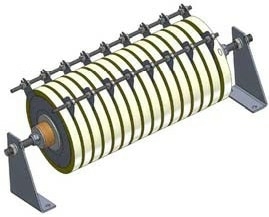source: AZO Materials news
An exciter in a synchronous generator is used to deliver the DC supply to the electromagnetic field winding which is mounted on the generator’s rotor. An appropriate means to discharge the stored energy in the field coil should be available in order to prevent damage that is being sustained to excitation systems during shut down.
Metrosil® silicon carbide varistors have offered a reliable solution for exciter discharge applications for many years and they are being employed in many OEMs in world flagship power projects.
Transients may be produced in excitation systems when the voltage supplied to the field coil is removed, causing a quick reduction in current with time. The energy stored in the coil attempts to maintain the level of the current by producing a large back EMF, which may be many times larger than the supply voltage and may sufficiently be larger to damage other components in the system if uncontrolled.
A technique for controlling the level of the back EMF is to dissipate the current / energy stored in the coil into a suitable load, comprising of either a resistor or a varistor such as a Metrosil. The coil serves as a current source that discharges with time into the load during a discharge event. Then, the voltage produced across the load can be controlled and this voltage is in proportion to the resistance of the load and the current that flows through the load.
.jpg)
Discharge time characteristics for different discharge resistors.
.jpg)
3 Gorges dam, Hubei Province, China. The hydro power station uses Metrosil exciter discharge varistors.
Advantages of Metrosils in Exciter Discharge Systems
Metrosil offers a high-speed solution to the discharge of excitation systems. This is due to the degree of non-linearity in the V-I characteristics of the discs.
In addition to providing short discharge times, Metrosil can also be employed in high energy applications, because the discs may be matched easily. This ‘matching’ describes how the difference in the electrical properties of the discs establishes the sharing of energy and current within a Metrosil.
If the discs are not matched appropriately in a unit, it may cause uneven current and energy distributions in the unit and limit the rating of the unit or probably lead to failure. Problems in matching with highly non-linear varistors limits their utilization to low energy applications.
Metrosil combines the energy absorption capability and the ideal characteristics of non-linearity for exciter discharge applications.
.jpg)
An unspaced Metrosil unit as used in a switched static exciter discharge system.
Customized Solutions
For medium to large exciter discharge applications, it is normal to switch in the exciter discharge system at the same time as switching out the supply voltage. This can be attained through a field breaker or a thyristor crowbar control system. This technique is widely employed in static excitation systems.
.jpg)
Typical arrangement of a switched exciter discharge circuit.
The user defines the following parameters of the system in order to develop a customized unit for an exciter discharge application:
- Maximum discharge current from the field coil
- Required protection voltage under discharge conditions
- Energy stored in the field coil
Considerations for the protection voltage and energy to be dissipated must also be made regarding the three-phase short-circuit currents, which can be up to three times the level of the maximum discharge current.
A suitable unit may then be defined by the Metrosil engineers. Many units employ 150 mm diameter discs, which are coupled in series and parallel arrangements, based on the necessary electrical parameters. The number of discs and their thickness is dependent on the application details.
.jpg)
Metrosil exciter discharge units arranged in parallel in a large hydro power system.
Alternative Exciter Discharge Systems
Customized units suitable for brushless and permanently connected exciter discharge systems – as employed on smaller synchronous generators – can be provided. A wider range of parameters should be considered in these applications, including:
- The mechanical stability of the unit
- Leakage current considerations
- Power dissipation under normal operating conditions
.jpg)
Metrosils installed on a generator with a brushless excitation system.
.jpg)
A spaced Metrosil unit as used in a permanently connected static exciter discharge system.
.jpg)
Large static excitation system showing Metrosil unit mounted from the cabinet ceiling.































